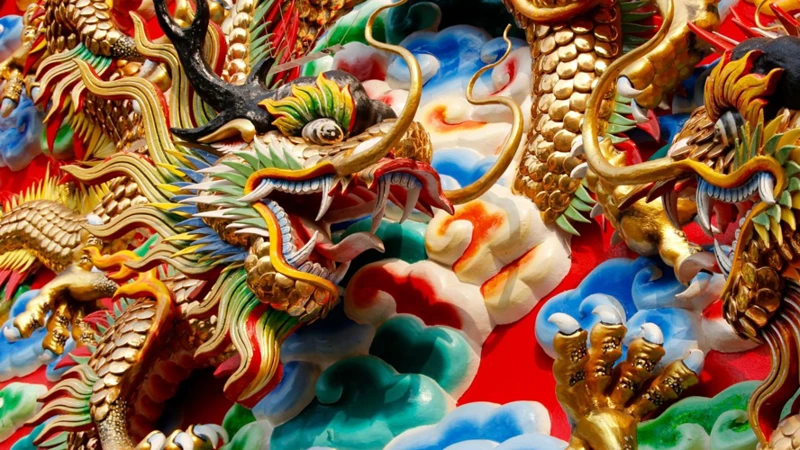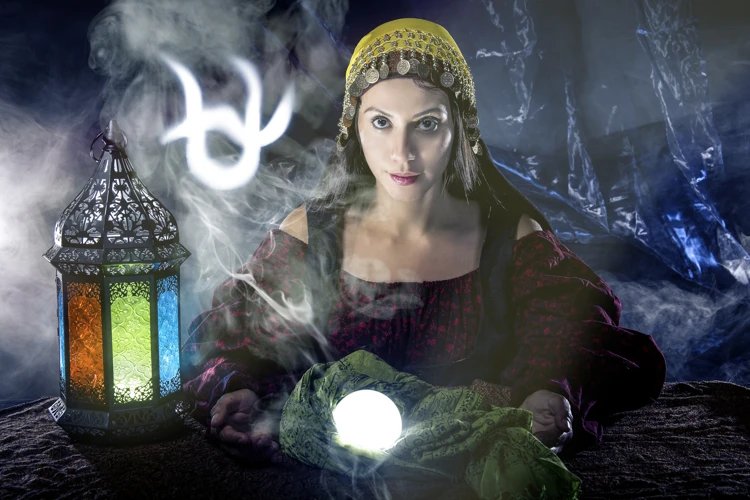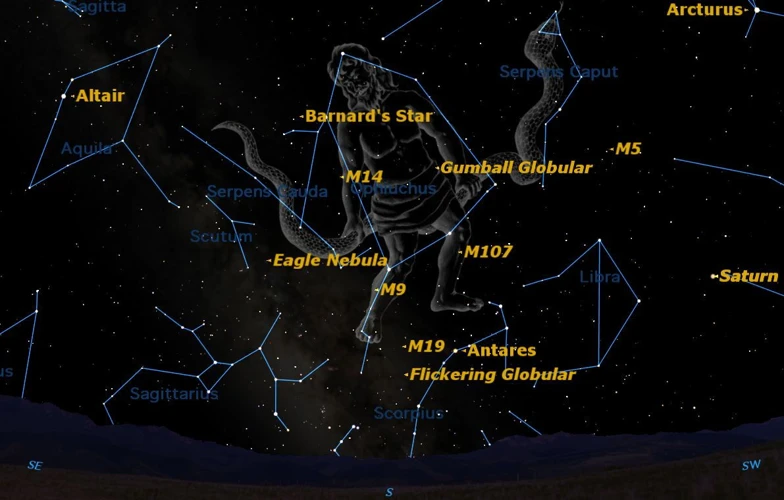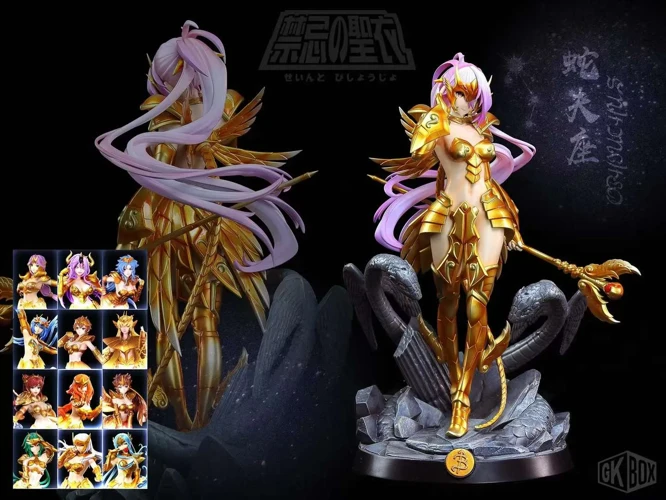In the vast and enchanting realm of Greek mythology, a world filled with captivating gods, powerful heroes, and awe-inspiring tales, lies a plethora of mythical creatures that have both fascinated and terrified mortals for centuries. From the half-human, half-horse creatures known as centaurs to the petrifying gaze of Medusa, these creatures have captured the imaginations of people across cultures and generations. While some of these beings, like the minotaur and sirens, have gained widespread recognition, others, such as the harpies and nymphs, remain lesser-known but equally intriguing. Join us on a journey through this mesmerizing world as we explore the origins, legends, and encounters of these fascinating Greek mythical creatures.
Contents
- Origins of Mythical Creatures
- Popular Greek Mythical Creatures
- Lesser-Known Greek Mythical Creatures
- Legendary Encounters and Tales
- Conclusion
-
Frequently Asked Questions
- 1. What is the significance of mythical creatures in Greek mythology?
- 2. How were mythical creatures believed to be born in Greek mythology?
- 3. Are there any lesser-known Greek mythical creatures?
- 4. Who were the heroes known for battling mythical creatures?
- 5. Are mythical creatures considered good or evil in Greek mythology?
- 6. Are there any connections between Greek mythical creatures and constellations?
- 7. Can mythical creatures be found in other mythologies and cultures?
- 8. What are some famous literary works that feature Greek mythical creatures?
- 9. Are there any modern adaptations or representations of Greek mythical creatures?
- 10. Can we learn anything from the stories of Greek mythical creatures?
- References
-
Frequently Asked Questions
- FAQs about Greek Mythical Creatures
- Curious about the fascinating world of Greek mythical creatures? Here are some frequently asked questions about these captivating beings:
- 1. Are Greek mythical creatures real?
- 2. What is the significance of Greek mythical creatures?
- 3. How were Greek mythical creatures created?
- 4. Are there any real-life inspirations for Greek mythical creatures?
- 5. Which Greek mythical creature is the most famous?
- 6. What is the story of the Minotaur?
- 7. Do Greek mythical creatures have any weaknesses?
- 8. Can Greek mythical creatures be benevolent?
- 9. Were Greek mythical creatures worshiped or revered by the ancient Greeks?
- 10. Can Greek mythical creatures be found in other mythologies?
- References
- Read More
Origins of Mythical Creatures

The origins of these captivating mythical creatures can be traced back to the rich tapestry of Greek mythology. Within the intricate web of ancient Greek tales and legends, these creatures found their beginnings as fantastical beings of immense power and symbolism. It is believed that these creatures were born from the gods themselves, or as a result of divine intervention in the mortal world. The gods and goddesses of Greek mythology were known for their extraordinary abilities and often had relationships with mortals, leading to the birth of hybrid beings such as centaurs and nymphs. These mythical creatures served as a representation of the supernatural and the unpredictable forces of nature, embodying both the beauty and danger of the world. Their stories, passed down through generations, continue to captivate and intrigue us, offering a glimpse into the rich and complex world of Greek mythology. To further explore the origins of these mythical creatures, we can delve into the fascinating realm of the Greek gods and goddesses, where their existence intertwines with the celestial and mortal realms.
The Role of Greek Mythology
As an integral part of ancient Greek culture and belief system, Greek mythology played a significant role in the lives of the people. It served as a way to explain the mysteries of the world around them, providing a framework for understanding natural phenomena, human behavior, and the essence of existence itself. Greek mythology was not only a collection of stories, but also a reflection of the values, ideals, and fears of the society. It provided moral lessons and guidance, showcasing the consequences of hubris, betrayal, and heroism. These mythical tales were shared through oral tradition, art, and later in written form, ensuring their longevity and influence throughout history. Through gods, goddesses, and mythical creatures, Greek mythology vividly portrayed the extraordinary and the monstrous, giving shape to the collective imagination. It also served as a means of connecting mortals to the divine, offering a glimpse into the larger cosmic order. To truly understand the origins and significance of the mythical creatures, it is essential to examine the overarching role of Greek mythology in shaping not only ancient Greek society but also its enduring impact on art, literature, and contemporary culture.
Popular Greek Mythical Creatures

Popular Greek Mythical Creatures:
1. Centaurs: These legendary creatures are known for their half-human, half-horse composition. With the torso and head of a human and the body of a horse, centaurs were often depicted as fierce warriors, skilled in archery and horsemanship. They played significant roles in Greek mythology, appearing in stories such as the battle against the Lapiths and their association with the centaur Chiron, a wise and revered figure who mentored many famous heroes.
2. Medusa: One of the most recognizable Greek mythical creatures, Medusa was a terrifying creature with snakes for hair and a gaze so petrifying that it turned anyone who looked into her eyes to stone. She was once a beautiful mortal woman but was cursed by the goddess Athena as punishment for her romantic involvement with Poseidon. Medusa’s iconic head, which retained its petrifying power even after her death, became a symbol of protection and was placed on shields and in temples.
3. Minotaur: The Minotaur was a fearsome creature with the body of a man and the head of a bull. It dwelled in the labyrinth of King Minos of Crete and was said to be the offspring of Minos’ wife Pasiphae and a bull. Every year, the Athenians were forced to send a sacrifice of young men and women to the labyrinth to be devoured by the Minotaur until Theseus, aided by the princess Ariadne, successfully navigated the labyrinth and defeated the monstrous creature.
4. Sirens: The sirens were enchanting creatures, often depicted as beautiful women with the wings and songs of birds. They lured sailors with their mesmerizing voices, causing them to shipwreck on the rocky shores of their islands. These mythical beings symbolized the dangers and temptations that sailors faced at sea. The most famous encounter with the sirens is found in Homer’s epic, “The Odyssey,” where the hero Odysseus nearly succumbs to their irresistible songs.
5. Chimera: A fearsome and mythical creature, the chimera had the body of a lion, the head of a goat, and the tail of a serpent. It possessed the ability to breathe fire and wreak havoc. The monster was finally defeated by the hero Bellerophon, mounted on the winged horse Pegasus, who used his cunning and the help of the goddess Athena to slay the chimera, protecting the land of Lycia from its fiery rampage.
These popular Greek mythical creatures continue to captivate imaginations and inspire countless works of art, literature, and entertainment. Each one carries with it a unique and powerful symbolism that reflects the complex nature of the ancient Greek world.
1. Centaurs
Centaurs, the half-human, half-horse creatures, are among the most iconic and recognizable mythical beings from Greek mythology. These fascinating creatures were believed to be born from the union of Ixion, a mortal king, and Nephele, a cloud nymph. Known for their untamed nature and exceptional strength, centaurs were often portrayed as boisterous and wild, embodying both the human and animal instincts. They were skilled warriors and renowned for their archery skills. In Greek mythology, the centaurs played a significant role in various tales and legends. One notable encounter involves the heroic Hercules, who battled against vicious centaurs as one of his Twelve Labors. Centaurs symbolize the juxtaposition of civilization and savagery, highlighting both the primal and intellectual aspects of human nature. To further immerse ourselves in the captivating world of Greek mythology, let’s explore the mythical origins of these incredible beings and their enduring impact on ancient Greek culture.
2. Medusa
Medusa, one of the most feared and iconic figures in Greek mythology, is a creature whose tale is steeped in both tragedy and horror. Often depicted as a monstrous woman with snakes for hair, her mere gaze had the power to turn any who met her eyes into stone. The origins of Medusa vary in different accounts, but one common version states that she was originally a beautiful mortal woman who caught the attention of the sea god Poseidon. They crossed paths in the temple of Athena, resulting in Poseidon and Medusa desecrating the sacred space. Enraged by this act, Athena punished Medusa by transforming her once beautiful locks into a snaky mass and cursing her with the petrifying gaze. This transformation turned Medusa into a fearsome and terrifying creature, forever exiled from her former life to roam as a monster. Her story serves as a cautionary tale about the consequences of defying the gods and the dangers of unchecked beauty and power. To this day, the image of Medusa continues to captivate artists, writers, and storytellers, symbolizing both the allure and danger that exists in the world. To learn more about the various constellations in Greek mythology, including the connections to celestial harps, you can explore the Lyra constellation and Vega, the celestial harp.
3. Minotaur
The minotaur, a fearsome creature of Greek mythology, holds a prominent place among the popular mythical beings. This creature, with the head of a bull and the body of a man, was said to dwell within the twisting labyrinth of King Minos in ancient Crete. Its origins can be traced to a tragic tale intertwined with power, betrayal, and divine retribution. According to the myth, the minotaur was born from the union between the Cretan queen Pasiphae and a bull sent by Poseidon, the god of the sea. The monstrous offspring, half-human and half-bull, wreaked havoc upon the land, devouring the sacrifices demanded by King Minos. The Athenian hero Theseus, aided by Princess Ariadne, ventured into the labyrinth to face this legendary creature. With the help of a thread provided by Ariadne, Theseus successfully defeated the minotaur, marking the end of its terror. The tale of the minotaur serves as a cautionary reminder of the consequences of hubris and the power of determination. To further explore the significance of mythical creatures like the minotaur, we can also delve into the symbolism and lessons they represent within the realm of Greek mythology.
4. Sirens
The Sirens, one of the most well-known Greek mythical creatures, are notorious for their enchanting voices and irresistible allure. Often depicted as beautiful women with the wings of birds, they possessed the ability to mesmerize sailors with their captivating songs. These songs, said to be irresistible to anyone who heard them, lured sailors towards treacherous rocky shores, causing their ships to crash and sink. The Sirens’ haunting melodies were said to be capable of stirring deep desires within those who listened, leading to their demise. These creatures were believed to reside on the rocky islands of Anthemoessa, located in the western part of the Mediterranean Sea. Sailors, driven by their insatiable desire to find the source of these enchanting songs, would often become lost in their pursuit, falling prey to the fatal allure of the Sirens. Stories of their encounters with these mystical beings continue to serve as cautionary tales, reminding us of the dangers that lie in being lured by temptation. To discover more intriguing stories of creatures and their tales, delve into the mesmerizing world of legendary myths and legends.
5. Chimera
The Chimera, ranked at number 5 among the popular Greek mythical creatures, is a fearsome beast with a fascinating origin. According to legend, the Chimera was a monstrous creature with the body of a lion, the head of a goat protruding from its back, and a serpent’s tail. This combination of different animals made the Chimera an embodiment of chaos and hybridity. The ferocity of the lion, the cunning of the goat, and the venomous nature of the serpent all contributed to its terrifying reputation. The origins of the Chimera trace back to its parentage – Typhon, a monstrous giant, and Echidna, a half-woman, half-serpent creature. The Chimera’s fiery breath, which could scorch the earth and turn anything it touched to ashes, made it a formidable opponent. It terrorized the kingdom of Lycia until it was eventually slain by the hero Bellerophon, riding the winged horse Pegasus. The story of the Chimera serves as a reminder of the ancient Greeks’ fascination with the extraordinary, the monstrous, and the hero’s journey to overcome seemingly insurmountable challenges.
Lesser-Known Greek Mythical Creatures

Lesser-known Greek mythical creatures add an extra layer of mystique to the already enchanting world of Greek mythology. These creatures may not be as widely recognized as their counterparts, but they possess their own unique tales and characteristics that are worth exploring. One such creature is the harpy, a winged being with the head and torso of a woman and the wings, talons, and beak of a bird. Harpies were known as the personification of storm winds, and their name translates to “snatchers” or “robbers,” emphasizing their reputation for swooping down and seizing individuals. Another intriguing creature is the Sphinx, a creature with the body of a lion and the head of a human or animal. The Sphinx was known for its riddles, posing them to travelers and devouring those who failed to answer correctly. The Cyclops, often portrayed as giant one-eyed creatures, were said to be the children of the gods, known for their immense strength and craftsmanship. Nymphs, on the other hand, were female spirits associated with nature, residing in various locations like forests, mountains, and bodies of water. Lastly, there is Cerberus, the fearsome three-headed dog that guarded the entrance to the Underworld, preventing the escape of souls. These lesser-known creatures contribute to the vast and diverse world of Greek mythology, offering a glimpse into the richness and complexity of ancient Greek storytelling.
1. Harpies
Harpies, with their fascinating and haunting presence, are one of the lesser-known Greek mythical creatures. These winged beings, often depicted as part bird and part woman, are believed to have originated from a union between the sea god Thaumas and the ancient ocean nymph Electra. Known for their swiftness and agility, harpies were notorious for their ability to snatch away food or objects with incredible speed, leaving behind chaos and destruction. Their sharp claws and beaks were used to seize their prey, be it animals or humans. In Greek mythology, harpies were often seen as agents of punishment and were sent by the gods to torment those who had committed acts of transgression or displayed arrogance. They were described as foul and menacing, with feathers that were perpetually dirty and matted. While harpies are not as widely recognized as some other mythical creatures, their presence in ancient Greek tales serves as a reminder of the untamed and unpredictable forces in the world, where beauty and brutality coexist.
2. Sphinx
The Sphinx, with its enigmatic riddle and magnificent lion’s body fused with the head of a human, is one of the most iconic and mysterious Greek mythical creatures. According to legend, the Sphinx resided near the city of Thebes and posed a riddle to passersby. Anyone who failed to answer correctly would meet a disastrous fate. The riddle asked: “What creature walks on four legs in the morning, two legs at noon, and three legs in the evening?” The answer, of course, is a human who crawls as a baby, walks upright as an adult, and uses a cane in old age. The Sphinx’s riddle was said to represent the complexity and ever-changing nature of human existence. Those who could not solve the riddle would be slain by the Sphinx, while those who succeeded would be allowed to pass unharmed. One of the most famous encounters with the Sphinx is the myth of Oedipus. Oedipus arrived in Thebes and encountered the Sphinx, successfully answering the riddle and freeing the city from the creature’s torment. The Sphinx’s role as a guardian and enigmatic figure has made it a symbol of wisdom, mystery, and the eternal quest for knowledge. To this day, the image of the Sphinx continues to captivate the imaginations of people around the world, inviting them to ponder its timeless riddle and unravel the secrets it holds.
3. Cyclops
The Cyclops, one of the most prominent and fearsome mythical creatures in Greek mythology, is a towering being with a single, large eye situated in the middle of its forehead. These colossal creatures are often depicted as violent and primitive, with a savage nature and tremendous strength. In Greek mythology, the Cyclops were the sons of Uranus (the sky) and Gaia (the earth). They were known as skilled blacksmiths, forging powerful weapons and objects for the gods. However, their brutish behavior and volatile temperament led to clashes with the divine beings. The most famous encounter with a Cyclops is depicted in Homer’s epic poem, the Odyssey, where the hero Odysseus and his men find themselves trapped in the lair of the Cyclops Polyphemus. To escape, Odysseus devises a clever plan, using his cunning wit to blind the Cyclops and lead his crew to safety. This tale showcases the resourcefulness and intelligence of mortals in the face of daunting mythical adversaries. The Cyclops, with their unique appearance and terrifying demeanor, stand as a testament to the intricate and diverse world of Greek mythology, where both heroism and danger await at every turn.
4. Nymphs
Nymphs, often depicted as beautiful and ethereal female figures, are enchanting creatures that hold a significant place in Greek mythology. These immortals were believed to reside in various elements of nature, including forests, mountains, rivers, and springs. Nymphs were associated with specific natural features such as trees, fountains, and meadows, and their presence was believed to bring fertility and abundance to the surrounding areas. There were different types of nymphs, each with their own domain and characteristics. For example, dryads were nymphs of the trees, while naiads were nymphs of the water. Nymphs were known for their mesmerizing beauty, often described as divine and alluring. They were also believed to possess exceptional singing and dancing abilities, captivating anyone who encountered them. These creatures played significant roles in Greek mythology, sometimes serving as companions or lovers to gods and heroes. The tales of the nymphs are intertwined with various legends, providing both wonder and fascination. Their existence and connections to nature make them intriguing subjects of exploration for those who seek to understand the depths of Greek mythology.
5. Cerberus
Cerberus, also known as the Hound of Hades, is a fearsome creature in Greek mythology. As the guardian of the underworld, Cerberus is depicted as a gigantic three-headed dog with a serpent for a tail. Each head of Cerberus possesses sharp teeth and a voracious appetite, ready to devour any intruders who dare to venture into the realm of the dead. The mere sight of Cerberus is enough to strike fear into the hearts of mortals and even some gods. According to myth, Cerberus was the offspring of Echidna, a half-woman half-serpent monster, and Typhon, a giant who challenged the Olympian gods.
Cerberus played a crucial role in Greek mythology as the guardian of the gates of the underworld, ensuring that no souls could escape and no living being could enter without permission. The hero Hercules, as part of his Twelve Labors, was tasked with capturing Cerberus. With his immense strength, Hercules managed to overpower the fearsome beast and bring it to the surface world for a brief period. This encounter showcased the hero’s bravery and strength, solidifying his status as one of the greatest heroes in Greek mythology.
The symbolism of Cerberus is intertwined with the concept of death and the afterlife in Greek mythology. The relentless guarding of the gates of the underworld represents the finality and unescapable nature of death. Cerberus serves as a reminder that there are boundaries and consequences in the mortal realm, and that one must face their actions in life before entering the realm of the dead. The imagery of Cerberus continues to captivate and inspire artists, writers, and storytellers, reminding us of the power and mystery surrounding the realm of death in Greek mythology.
Legendary Encounters and Tales

Legendary encounters and tales involving Greek mythical creatures have been passed down through the ages, captivating audiences with their fantastical and often perilous nature. The ancient Greek heroes, known for their courage and strength, often found themselves facing these formidable creatures in epic battles. These heroic encounters have become the stuff of legends, showcasing the triumph of mortals against seemingly insurmountable odds. One such legendary battle was that of the hero Heracles against the fearsome Hydra, a serpent-like creature with multiple heads. Despite the hydra’s regenerative powers, Heracles was able to defeat it with the help of his cunning and strength. Another famous tale is that of the hero Odysseus and the enchanting Sirens, whose irresistible voices lured sailors to their doom. Odysseus, aware of the Sirens’ deadly allure, devised a plan to navigate their treacherous waters unscathed. These legendary encounters not only highlight the bravery of the heroes but also the formidable nature of the mythical creatures they encountered. These tales continue to inspire and captivate us, showcasing the enduring allure of Greek mythology and its mythical creatures.
Ancient Heroes Battling Mythical Creatures
Ancient Greek mythology is replete with thrilling tales of heroic individuals who faced daunting challenges, including epic battles against terrifying mythical creatures. These heroes, renowned for their strength, courage, and cunning, stood as formidable adversaries against these creatures, showing their valor and determination. One such legendary hero is Hercules, known for his Twelve Labors, which involved battling numerous mythical creatures. Among his conquests was the defeat of the Nemean Lion, a fierce creature with impenetrable skin, and the slaying of the Hydra, a multi-headed serpent-like monster. Perseus, another iconic hero, confronted the fearsome Medusa and used his cunning to defeat her by avoiding her petrifying gaze and using a mirrored shield to eventually vanquish her. These tales of ancient heroes facing off against mythical beasts not only highlight the physical prowess and bravery of these individuals, but also the significance of these creatures in Greek mythology. It showcases how the mythical creatures played an integral role in the grand narratives of heroism and the eternal struggle between mortals and the divine.
Misunderstood Creatures and their Plight
Misunderstood creatures, often the subject of fear and tales of terror, have their own unique plight in Greek mythology. While many of these creatures are portrayed as malicious and dangerous, a closer look reveals a more complex perspective. One such example is the harpies, winged creatures with the face of a woman and the body of a bird. They are often depicted as tormentors, stealing food and carrying away the souls of the deceased. However, it is important to note that in some versions of the myth, the harpies were actually sent by the gods as agents of punishment, carrying out divine retribution. This adds a layer of nuance to their character, raising questions about the nature of justice and the role of these creatures in the grand scheme of things.
Another misunderstood creature is the sphinx, a mythical creature with the head of a human and the body of a lion. The sphinx is often remembered for her deadly riddles, devouring those who fail to answer correctly. However, there is a tragic backstory to this creature. In one version of the myth, the sphinx was a woman cursed by the gods, forced to ask riddles in order to prevent people from passing through the city. This curse was lifted once Oedipus successfully answered her riddle, allowing her to finally rest in peace. This tale showcases the complexity of these creatures, highlighting the notion that they are not simply embodiments of evil, but rather victims of circumstance.
The cyclops, with its single eye and towering size, is yet another misunderstood creature. Often depicted as violent and savage, the cyclops is best known for its encounter with the hero Odysseus in Homer’s Odyssey. However, it is interesting to note that in other myths, cyclops can be seen as skilled craftsmen and builders. They were said to have forged powerful weapons for the gods, showcasing a different side to their character.
These examples demonstrate the potential for misconceptions and misunderstandings when it comes to mythical creatures. While they may possess frightening or menacing traits, it is important to dig deeper and consider the root of their actions and their true nature. By acknowledging the complexities and layers of these creatures, we can gain a deeper appreciation for their place in Greek mythology and the themes they represent.
Conclusion

In conclusion, the world of Greek mythical creatures is a captivating and diverse realm that continues to mesmerize us with its rich lore and fascinating tales. From the well-known figures like centaurs, Medusa, and the minotaur, to the lesser-known but equally intriguing creatures such as harpies and nymphs, these mythical beings have stirred our imagination for centuries. The origins of these creatures can be traced back to the intricate web of Greek mythology, where they were born from the gods themselves or as a result of divine intervention in the mortal world. They serve as representations of the supernatural forces of nature, embodying both beauty and danger. Through ancient stories and legends, we have encountered the heroes who bravely faced these creatures, as well as the misunderstood ones who faced prejudice and hardship. The world of Greek mythical creatures offers a glimpse into the boundless creativity and imagination of ancient civilizations, and it continues to inspire artists, writers, and storytellers today. So, let us immerse ourselves in the fascinating world of Greek mythical creatures and unravel the mysteries that lie within.
Frequently Asked Questions

1. What is the significance of mythical creatures in Greek mythology?
Mythical creatures in Greek mythology hold great symbolic significance. They represent the forces of nature, embodying both the beauty and danger of the world. They highlight the blurred line between the divine and mortal realms and invoke a sense of awe and wonder.
2. How were mythical creatures believed to be born in Greek mythology?
According to Greek mythology, mythical creatures were born from the gods themselves or as a result of divine intervention in the mortal world. They were often the offspring of gods and mortals, resulting in hybrid beings with extraordinary abilities.
3. Are there any lesser-known Greek mythical creatures?
Absolutely! While creatures like centaurs and Medusa are well-known, there are also lesser-known beings in Greek mythology. Some examples include harpies, sphinxes, cyclopes, and nymphs, each with their own unique stories and characteristics.
4. Who were the heroes known for battling mythical creatures?
Several heroes in Greek mythology were renowned for their battles against mythical creatures. These include Perseus, who famously defeated Medusa, and Theseus, who faced and conquered the dreaded minotaur.
5. Are mythical creatures considered good or evil in Greek mythology?
Mythical creatures in Greek mythology do not fall strictly into the categories of good or evil. They are complex beings with their own motivations and characteristics. Some, like the centaurs, were known for their wisdom and ability to heal, while others, like the harpies, were seen as frightening and destructive.
6. Are there any connections between Greek mythical creatures and constellations?
Yes, there are connections between Greek mythical creatures and constellations. For example, the Lyra constellation is associated with the harpy, a creature known for its wings and bird-like features. Vega, a star in the Lyra constellation, is often referred to as the “celestial harp.”
7. Can mythical creatures be found in other mythologies and cultures?
Absolutely! Many mythologies and cultures around the world have their own versions of mythical creatures. While the specific characteristics and stories may vary, the presence of these beings showcases a universal fascination with the mysteries of the world and the supernatural.
8. What are some famous literary works that feature Greek mythical creatures?
Greek mythical creatures have inspired numerous literary works throughout history. Some famous examples include the epic poems “The Odyssey” and “The Iliad” by Homer, where creatures like sirens and cyclopes make appearances, as well as the play “Oedipus Rex” by Sophocles, which includes the sphinx.
9. Are there any modern adaptations or representations of Greek mythical creatures?
Yes, Greek mythical creatures continue to inspire and captivate modern audiences. They can be found in various forms of media, from books and movies to art and video games. Their enduring popularity speaks to their timeless appeal.
10. Can we learn anything from the stories of Greek mythical creatures?
Indeed, the stories of Greek mythical creatures offer valuable insights into human nature, the significance of storytelling, and the complex interplay between gods and mortals. They also provide a window into ancient Greek culture and belief systems, helping us better understand the narratives that shaped their world.
References
- Greek Monsters
- Treasures Of Greek Mythology: Step Inside The …
- Greek Mythology Monsters: Full list and description
Frequently Asked Questions

FAQs about Greek Mythical Creatures
Curious about the fascinating world of Greek mythical creatures? Here are some frequently asked questions about these captivating beings:
1. Are Greek mythical creatures real?
No, Greek mythical creatures are not real. They are part of Greek mythology, a collection of stories and beliefs from ancient Greece.
2. What is the significance of Greek mythical creatures?
Greek mythical creatures play a significant role in Greek mythology as they represent various aspects of human nature, fears, and desires. They also serve as symbols and metaphors in ancient Greek literature.
3. How were Greek mythical creatures created?
Greek mythical creatures were created through a combination of storytelling, imagination, and cultural beliefs. They were popularized through ancient Greek literature, art, and oral traditions.
4. Are there any real-life inspirations for Greek mythical creatures?
While some Greek mythical creatures may have been inspired by real animals or natural phenomena, their existence only exists within the realm of mythology. Their depictions and characteristics are often a product of human imagination.
5. Which Greek mythical creature is the most famous?
Among the many Greek mythical creatures, Medusa is often considered one of the most famous. Her snake-like hair and ability to turn people to stone have made her a prominent figure in Greek mythology.
6. What is the story of the Minotaur?
The Minotaur was a creature with the body of a human and the head of a bull. According to mythology, it was imprisoned in a labyrinth on the island of Crete and defeated by the hero Theseus.
7. Do Greek mythical creatures have any weaknesses?
Yes, many Greek mythical creatures have specific weaknesses or vulnerabilities. For example, Medusa could be killed by beheading her, while the Minotaur was eventually defeated by Theseus.
8. Can Greek mythical creatures be benevolent?
While some Greek mythical creatures, like the Centaurs, have been depicted as benevolent and wise, others, such as the Harpies, are often portrayed as malevolent and dangerous.
9. Were Greek mythical creatures worshiped or revered by the ancient Greeks?
No, Greek mythical creatures were not worshiped or revered like the gods and goddesses of Greek mythology. They were seen as part of the natural order of the world and as beings to be respected or feared.
10. Can Greek mythical creatures be found in other mythologies?
Similar creatures or mythological beings can be found in various mythologies around the world, although they may differ in their specific attributes and cultural significance. Examples include the Sphinx in Egyptian mythology and the Naga in Hindu mythology.
References
- Treasures Of Greek Mythology: Step Inside The …
- Greek Monsters
- The Most Famous Creatures from Greek Mythology







